Rare Books: A Glossary
Half bound — Italic
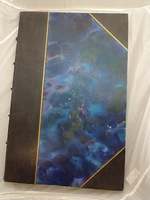
Half bound: A binding style where the spine, part of the boards, and the corners are bound in one material while the rest of the cover is bound in another material (or left unbound).
Image: Les Arts anciens de Flandre. Bruges: Siège de l'association, 1905. N2 .A78 (1905)
Half bound: A binding style where the spine, part of the boards, and the corners are bound in one material while the rest of the cover is bound in another material (or left unbound).
Hand: A style of manuscript script. The term can refer either to a manuscript alphabet (e.g., a late Gothic hand, insular uncial, Elizabethan secretary hand, or italic) or to a specific person’s handwriting (e.g., the book was written in one hand). A sketch of a hand in the margins is called a manicule.
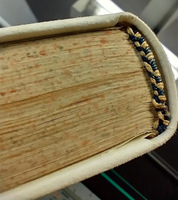
Headband: A band at the head and/or tail (i.e., the top or bottom edge) of the spine of a book. Headbands can be sewn (in which case they serve to reinforce the spine) or merely pasted on (in which case they just look nice). Islamic bindings are known for their distinctive chevron-shaped headbands.
Image: Ovid, 43 B.C.-17 A.D. or 18 A.D. Metamorphoses. 1502. Venice: Aldus Manuzio, 1502. PA6519 .M2 1502
Headband: A band at the head and/or tail (i.e., the top or bottom edge) of the spine of a book. Headbands can be sewn (in which case they serve to reinforce the spine) or merely pasted on (in which case they just look nice). Islamic bindings are known for their distinctive chevron-shaped headbands.

Historiation: The decoration of initials with images of people or animals rather than the more usual plants or floral designs.
Image: Catholic Church. Processional (for the use of the Dominican sisters of St. Louis, Poissy). Paris: approximately 1510-1540. BX2032 .A2 1510z
Historiation: The decoration of initials with images of people or animals rather than the more usual plants or floral designs.
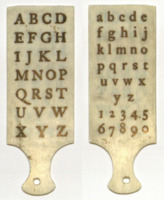
Hornbook: A pedagogical tool, consisting of a piece of paper attached to a wooden handle and covered by a thin plate of translucent horn. They were used in Europe and European colonies from the 16th century to the early 18th century. What exactly was on the paper would vary, but it typically included an alphabet, the ten Arabic digits, and a prayer.
Image: Tuer, Andrew White, 1838-1900. History of the horn-book. London: The Leadenhall Press and New York: Charles Scribner's Sons, 1897. 099 T81
Hornbook: A pedagogical tool, consisting of a piece of paper attached to a wooden handle and covered by a thin plate of translucent horn. They were used in Europe and European colonies from the 16th century to the early 18th century. What exactly was on the paper would vary, but it typically included an alphabet, the ten Arabic digits, and a prayer.
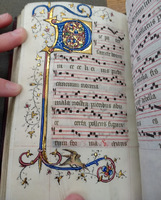
Illumination: The art of decorating books by hand, ranging from simple elaborations of letters with crosshatching to full-blown miniature landscapes drawn in the margins. Illumination is an art that was predominantly practiced in the Middle Ages, but it is still alive today. Medieval illuminators are (in)famous for their sense of whimsy and there are entire social media sites dedicated to ferreting out amusing illuminations of knights riding on snails, monkeys performing medical procedures, and cats engaging in household chores.
Image: Catholic Church. Processional (for the use of the Dominican sisters of St. Louis, Poissy). Paris: approximately 1510-1540. BX2032 .A2 1510z
Illumination: The art of decorating books by hand, ranging from simple elaborations of letters with crosshatching to full-blown miniature landscapes drawn in the margins. Illumination is an art that was predominantly practiced in the Middle Ages, but it is still alive today. Medieval illuminators are (in)famous for their sense of whimsy and there are entire social media sites dedicated to ferreting out amusing illuminations of knights riding on snails, monkeys performing medical procedures, and cats engaging in household chores.
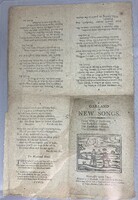
Imposition: The process of arranging type on the printing press so that that they appear on the paper in the right sequence after folding. Bibliographic format is dependent on proper imposition to work properly. Sometimes, printers would also print formats smaller than folio by a process called “half-sheet imposition” where the printed sheet would be cut in half to result in two smaller gatherings. A quarto by half-sheet imposition, for instance, would have one sheet of paper produce two smaller sheets, each of which can be folded in half to produce a gathering of two leaves.
Image: A Garland of new songs: Sweet Willy o' the green. The Yorkshire concert. The Yorkshire Irishman. The woodland maid. Newcastle upon Tyne: Printed by J. Marshall, between 1700 and 1799. PR1188.G37 S9 1700z
Imposition: The process of arranging type on the printing press so that that they appear on the paper in the right sequence after folding. Bibliographic format is dependent on proper imposition to work properly. Sometimes, printers would also print formats smaller than folio by a process called “half-sheet imposition” where the printed sheet would be cut in half to result in two smaller gatherings. A quarto by half-sheet imposition, for instance, would have one sheet of paper produce two smaller sheets, each of which can be folded in half to produce a gathering of two leaves.
![Hadriani Junii Batavia : in qua præeter gentis & insulæ antiquitatatem[!], originem, decora, mores, aliaque, ad eam historiam pertinentia, declaratur, quæ fuerit vetus Batavia, quæ Plinio, Tacito, & Ptolomæo cognita: quæ item genuina inclytæ Francorum nationis fuerit sedes Hadriani Junii Batavia : in qua præeter gentis & insulæ antiquitatatem[!], originem, decora, mores, aliaque, ad eam historiam pertinentia, declaratur, quæ fuerit vetus Batavia, quæ Plinio, Tacito, & Ptolomæo cognita: quæ item genuina inclytæ Francorum nationis fuerit sedes](https://library.missouri.edu/specialcollections/files/thumbnails/fef7ff4870097df6562b22518575033c.jpg)
Imprint: An identification of the printer responsible for producing a given book. Up until the late 1500s, the imprint usually appeared at the back of a book and was synonymous with the colophon, but it was eventually moved to the title page. Many printer’s imprints also included their devices or logos as printers did their best to draw attention to themselves and establish a loyal customer base.
Image: Junius, Hadrianus, 1511-1575. Hadriani Junii Batavia: in qua præeter gentis & insulæ antiquitatatem[!], originem, decora, mores, aliaque, ad eam historiam pertinentia, declaratur, quæ fuerit vetus Batavia, quæ Plinio, Tacito, & Ptolomæo cognita. Dordrecht: Vincentius Caimax, 1652. DJ107 .J9 1652
Imprint: An identification of the printer responsible for producing a given book. Up until the late 1500s, the imprint usually appeared at the back of a book and was synonymous with the colophon, but it was eventually moved to the title page. Many printer’s imprints also included their devices or logos as printers did their best to draw attention to themselves and establish a loyal customer base.
Impression: A technical term for the number of copies printed at one time, i.e., without removing the type or plates from the press. This is distinct from the edition (all copies of a book printed from one setting of type) and an issue (all copies put on sale at a given time). Impressions are tied to a fixed point in time and, after the invention of stereotyping in the 18th century, the term became more useful in terms of determining chronology than edition.

Incunable: A term for books printed in Europe between 1455 and 1500. The term derives from the Latin word incunabulum, meaning “cradle” as a reference to this period as the “cradle of printing.” The term is completely ahistorical and there is little difference in quality or style between books printed in 1499 and 1501, but it marks a convenient stopping point for studies focused on early printing.
Image: Thomas, Aquinas, Saint, 1225?-1274. Summa contra gentiles. Venice: Nicolas Jenson, 1480. BX1749 .T38 1480
Incunable: A term for books printed in Europe between 1455 and 1500. The term derives from the Latin word incunabulum, meaning “cradle” as a reference to this period as the “cradle of printing.” The term is completely ahistorical and there is little difference in quality or style between books printed in 1499 and 1501, but it marks a convenient stopping point for studies focused on early printing.
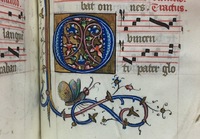
Initial: A term for when the first letter of a chapter or section is distinguished from other letters by its greater size and/or decoration. This practice began in the medieval manuscript tradition and was carried over by early printers, who either had initials added by a scribe or used a woodcut block to print the letter.
Image: Catholic Church. Processional (for the use of the Dominican sisters of St. Louis, Poissy). Paris: approximately 1510-1540. BX2032 .A2 1510z
Initial: A term for when the first letter of a chapter or section is distinguished from other letters by its greater size and/or decoration. This practice began in the medieval manuscript tradition and was carried over by early printers, who either had initials added by a scribe or used a woodcut block to print the letter.

Intaglio printing: A term for illustration processes where the design is cut into a surface, either with a tool (engraving) or with acid (etching). Intaglio printing is the opposite of relief printing. Generally speaking, intaglio prints have to printed separately from the text (unless the text is also cut into the intaglio plate) and were usually the purview of a specialist printer. Common forms of intaglio printing include engraving (whether in copper, steel, or wood), etching, drypoint, mezzotint, and aquatint.
Image: Contador de Argote, Jerónymo. Memorias para a historia ecclesiastica do Arcebispado de Braga: Primaz das Hespanhas. Lisboa Occidental: J. A. da Sylva, 1732-1747. BX1556 .B7 C6 1#3
Intaglio printing: A term for illustration processes where the design is cut into a surface, either with a tool (engraving) or with acid (etching). Intaglio printing is the opposite of relief printing. Generally speaking, intaglio prints have to printed separately from the text (unless the text is also cut into the intaglio plate) and were usually the purview of a specialist printer. Common forms of intaglio printing include engraving (whether in copper or steel), etching, drypoint, mezzotint, and aquatint.

Interleaved: An adjective referring to a book where the text is bound with blank leaves in an alternating pattern. This makes it easier to take notes while reading the book.
Image: Cicero, Marcus Tullius. Libri tres de officiis. Leipzig: Georg Heinrich Frommann, 1679. PA6296 .D5 1679
Interleaved: An adjective referring to a book where the text is bound with blank leaves in an alternating pattern. This makes it easier to take notes while reading the book.
Issue: A technical term for the number of copies of a book put on sale at any given time. This is distinct from an edition (all copies of a book printed from a single setting of type) and an impression (all copies printed at one time). Issues are distinct units of sale and are often described as such: 300 paper copies and 10 vellum copies, for instance, would be a description of an issue.
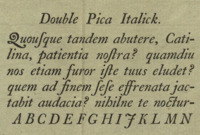
Italic: A style of letter in both manuscript and print. In manuscripts, italic refers to a style of handwriting prevalent in Italy during the early modern period. In printing, italic characters tend to be slanted and thinner than their roman counterparts. In both contexts, italic is associated with humanism.
Image: Wilson, Alex., & Sons, type-founders. A specimen of printing types. Glasgow: 1783. Z250 .W74 1783. Digitally available at the MU Digital Library.
Italic: A style of letter in both manuscript and print. In manuscripts, italic refers to a style of handwriting prevalent in Italy during the early modern period. In printing, italic characters tend to be slanted and thinner than their roman counterparts. In both contexts, italic is associated with humanism.